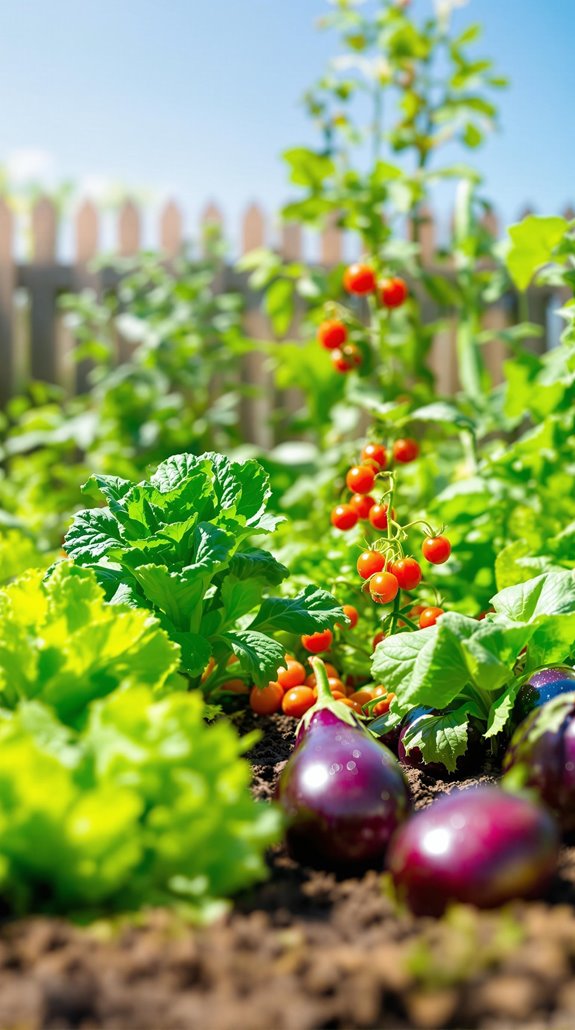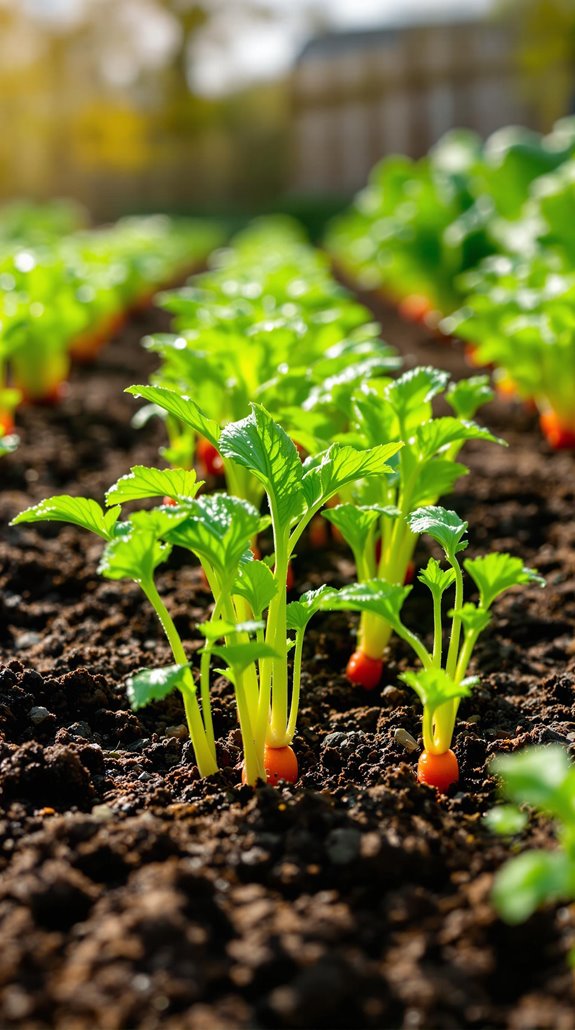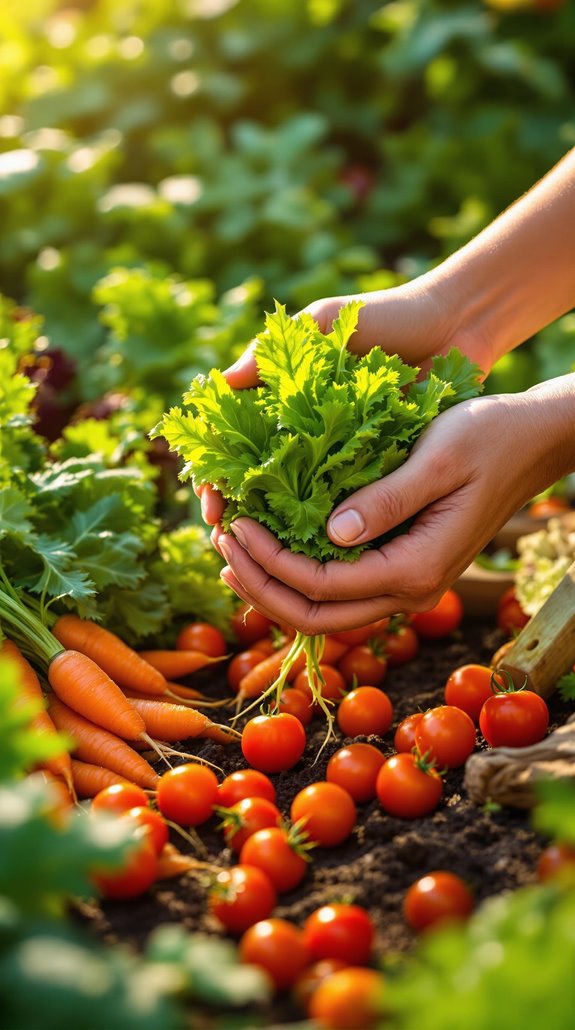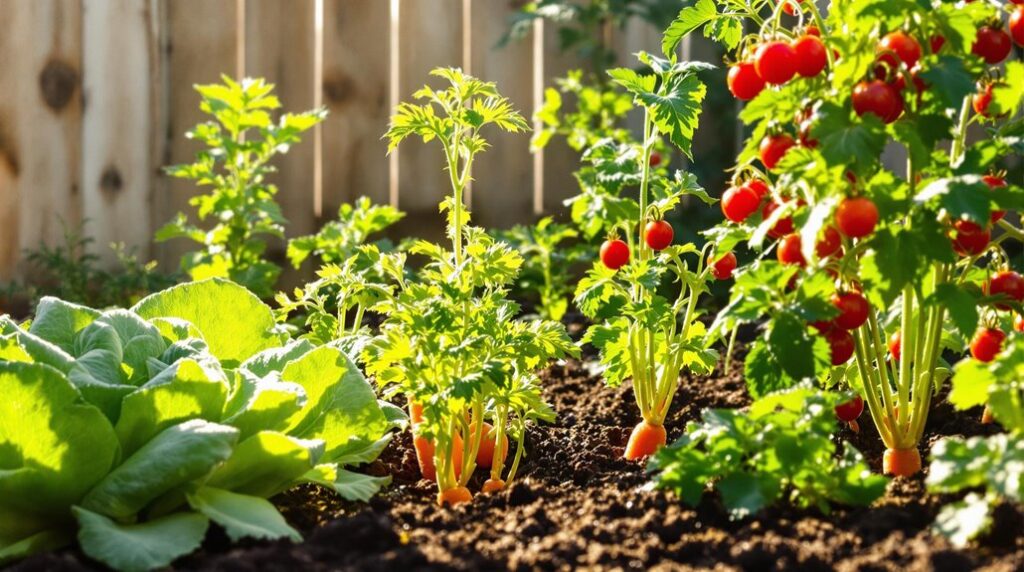I’ve spent years watching new gardeners struggle with complicated vegetables that demand constant attention and perfect conditions. The truth is, you don’t need to master complex techniques to grow your own food successfully. I’ve identified six vegetables that’ll thrive in Britain’s unpredictable weather while requiring minimal fuss from you. These crops will give you confidence, fresh produce, and the foundation skills you need—but there’s a specific order you should plant them in.
Key Takeaways
- Start with foolproof crops like potatoes, garlic, radishes, courgettes, and beetroot that thrive in UK conditions with minimal care.
- Ensure proper drainage and protect seedlings from frost using cloches or fleece during unpredictable UK weather.
- Begin sowing broad beans in February, peas in March, and use May for outdoor sowing of most vegetables.
- Water at soil level, mulch with compost, and thin seedlings early for healthy plant development and disease prevention.
- Use sharp tools for harvesting, support plants while picking, and brush soil off roots without washing for storage.
Why These Six Vegetables Are Perfect for Beginner Gardeners

When you’re starting your first vegetable garden, choosing the right crops can mean the difference between a thriving harvest and a frustrating failure. I’ve selected these six vegetables because they’re genuinely forgiving and deliver results even when you’re learning the ropes.
Potatoes and garlic require minimal ongoing effort after planting—perfect when you’re juggling gardening with everything else. Radishes mature in just 3-4 weeks, giving you quick wins that build confidence. Courgettes and beetroot thrive with basic watering and simple soil prep, avoiding complex feeding schedules.
These crops tolerate UK’s unpredictable weather patterns and resist common pests naturally. You’ll get abundant harvests from small spaces, proving that successful gardening isn’t about perfection—it’s about choosing plants that want to grow for you. Starting small with just a few well-chosen crops significantly increases your chances of achieving that rewarding first harvest.
Essential Growing Conditions for UK Climate Success
While choosing the right vegetables matters enormously, your success ultimately depends on creating the specific growing conditions that work with—not against—Britain’s challenging climate.
I’ll share the three non-negotiables that’ll transform your growing experience. First, sort your drainage—waterlogged soil kills more UK vegetables than anything else. If water sits after rain, you need raised beds or serious soil amendment. Second, protect against our unpredictable frosts with cloches or fleece during vulnerable seedling stages. Third, maximize every ray of precious sunlight by positioning heat-lovers like tomatoes in south-facing spots while embracing shade-tolerant crops like spinach elsewhere.
These aren’t suggestions—they’re the foundation that separates thriving gardens from disappointing ones in our unique climate. Get ahead of the season by starting your indoor sowing on windowsills or in unheated greenhouses before the main spring planting period arrives.
Planting Schedules and Timing for Maximum Yields

Getting your timing right makes the difference between a garden that produces sporadically and one that delivers continuous harvests throughout the growing season. I’ve learned that successful gardeners follow a strategic planting calendar rather than guessing when to sow.
Start your year with broad beans in February and peas in March – these hardy crops handle cold soil. May becomes your powerhouse month: sow beetroot, carrots, radishes, and spinach outdoors while starting pumpkins, broccoli, cabbage, courgettes, and cucumbers indoors.
June extends your outdoor sowing window for beetroot, carrots, lettuce, radishes, and spring onions. For heat-loving crops like tomatoes and aubergines, indoor sowing in early spring gives them the warmth they need before transplanting outdoors. Here’s my game-changer: succession planting. Sow peas every two weeks from March to June, and stagger your root vegetables monthly. This simple technique transforms sporadic harvests into abundant, continuous yields that’ll keep your kitchen stocked all season.
Simple Care Requirements That Actually Work
Although many gardeners overcomplicate vegetable care with elaborate systems and expensive tools, I’ve discovered that the most productive gardens thrive on simple, consistent practices.
I focus on three essential techniques that consistently deliver results. First, I water at soil level using a basic watering can or drip system—this prevents leaf diseases on tomatoes and peppers while maintaining steady moisture for beans and courgettes. Second, I mulch around plants with garden compost to suppress weeds and retain moisture naturally. Third, I thin seedlings early when they’re small, giving carrots and beetroot proper spacing to develop. For beetroot specifically, I ensure the soil is stone-free and avoid adding manure, which helps the roots develop properly.
These straightforward methods require minimal investment but maximize your harvest. You’ll spend less time troubleshooting problems and more time enjoying fresh vegetables from your thriving garden.
Harvesting Tips for the Best Flavor and Quality

When you harvest at the right moment using proper techniques, you’ll taste the difference immediately in your homegrown vegetables. I’ve learned that using sharp knives or garden shears creates clean cuts that prevent damage and disease. For peas and beans, I always support the plant with one hand while picking pods to avoid breaking stems.
Root vegetables like carrots need soil loosened with a fork first – never just yank them out. With beetroots, I twist the largest ones from clumps, leaving smaller roots to grow bigger.
After harvesting, I brush soil off roots without washing them, since moisture causes rot during storage. For leafy greens like lettuce, I wrap them in a damp cloth to retain moisture and keep them crisp. Proper handling post-harvest maintains quality and extends shelf life considerably.
Conclusion
I’ve shown you the six easiest vegetables that’ll guarantee your first UK garden succeeds. You’ve got the planting schedules, growing conditions, and care requirements – now it’s time to act. Grab your spade, pick your varieties, and start planting. Don’t overthink it; these crops forgive mistakes and reward effort. Your homegrown potatoes, garlic, radishes, courgettes, and beetroot are waiting. Stop planning and start growing – your garden won’t create itself.
References
- https://vegplotter.com/blog/easiest-veg-to-grow-in-the-UK
- https://theneguide.com/10-easiest-vegetables-to-grow-in-your-garden/
- https://www.gtech.co.uk/blog/11-easy-vegetables-you-can-plant-in-the-uk/
- https://greenecofriend.co.uk/easiest-vegetables-to-grow/
- https://restless.co.uk/leisure-and-lifestyle/home-garden/easy-to-grow-vegetables/
- https://sowmuchmore.co.uk/2023/01/13/easy-crops-for-beginners-and-how-to-grow-them/
- https://sproutedgarden.com/easy-to-grow-vegetables-for-beginners/
- https://envii.co.uk/blogs/news/easiest-veggies-to-grow-6-tips-for-starting-a-vegetable-garden
- https://www.easygardenirrigation.co.uk/blogs/news/uk-vegetable-planting-calendar
- https://letsgrowcook.co.uk/easy-vegetables-to-grow-uk/

